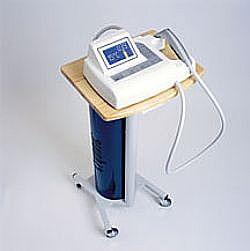CRYOTEK has released the Cryonic range of rapid treatment equipment that enables qualified first aid personnel to treat most types of workplace injuries.
Developed in France, the technology uses NeuroCryoStimulation in its CRYO+ (computerised indoor model) and DUO CRYO (portable model) to quickly immobilise in the early stages many soft tissue and musculoskeletal injuries that occur in the workplace.
Typical injuries treated include acute pain, torn muscles, oedemas, haematomas, dislocations, tendonitis, sprains, cramps, muscle spasms, and strained muscles, while it also aids muscle rehabilitation and post operation recovery.
Successful field tests throughout Europe by orthopaedic surgeons and physiotherapy practitioners ensured the product was quickly adopted by a growing list of hospitals in Belgium, Switzerland, Luxembourg, Germany and Spain as well as medical officers of top flight sports clubs including Chelsea Football Club, the France national football association and the England Ashes team.
NeuroCryoStimulation is a non-invasive, drug-free treatment for pain, inflammation and musculoskeletal trauma, enabling workers to recover and resume duties as quickly as possible. Workers can be treated immediately after injury. The treatment can be preventative, before and after duties. It is also affecting the treatment of chronic cases where a condition is recurrent or persistent.
Cryotek general manager Paul Gray says the uptake in Europe has been rapid primarily because the technology offers a new level of first aid at the workplace.
Rather than just sit and wait for an ambulance to reach an injured employee, OH&S officers can administer Cryotek to stop swelling, pain or bruising or any other negative development that could worsen injury before higher-level treatment arrives.
Yet for all its rapid effectiveness, the product requires only basic training to be used to its optimum and is cost effective to run, especially if it negates potentially costly workplace injury claims, says Gray.
The product combines the rapid applications of very low temperature under high pressure, together with sonic wave vibrations, to induce a thermal shock that triggers a reflex and bio-chemical response from the brain.
Applied with the Cryonic appliance, CO2 gas can lower the skin temperature from 32 degrees Celsius to five degrees Celsius in about 30 seconds. This rapid cooling can only be achieved with the Cryonic appliance and is vital to induce thermal shock.
The thermal shock translates into critical physiological benefits:
- Analgesic effect: inhibition of pain receptors gives immediate relieffrom pain.
- Anti-inflammatory effect: an increase in the permeability of muscular tissue suppresses the synthesis of the enzymes responsible for inflammation.
- Vasomotor effect: reduction of haematomas and oedemas. The blood and lymph system is flushed out by the increase in flow from a sudden and rapid dilation of the vessels.
- Muscle relaxant effect: the cumulative effect of very low temperature, high pressure and sonic wave vibrations relaxes the muscle fibres.
A key component of the system is the applicator developed and patented by Cryonic after years of research and development in gas cryotherapy.
This applicator is a gun that uses advanced technology to safely deliver medical CO2 gas at a very low temperature (minus 78 degrees Celsius) and under very high pressure (50 bar).
The NeuroCryoStimulation technique uses liquid medical CO2 gas. This gas has been specially chosen and is important for the technique and for the conditions it treats.
Medical CO2 gas is 99.99 percent pure. The same gas is used in hospitals for internal examinations. It causes less discomfort or pain. Pain from cold is primarily caused by humidity. A dry cold is more bearable than a wet cold such as from an ice pack. Humidity also acts on the texture of tissues especially in the case of a fresh wound.
Another important property of the gas is that it inhibits the growth and multiplication of bacteria and it destroys fungi. It presents no risk of infection.






